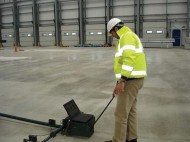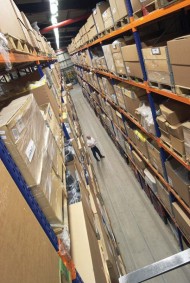 Martin Rogers, Managing Director of Combined Flooring Services, explains the principles involved in attaining the perfect floor surface for VNA installations.
Martin Rogers, Managing Director of Combined Flooring Services, explains the principles involved in attaining the perfect floor surface for VNA installations.
For many years, one of my learned colleagues in the fork lift truck industry has been telling me that every successful VNA installation relies upon three key elements:
Without this combination, a VNA installation is unlikely to operate to its maximum potential. Considering it in this way puts things into perspective.
The warehousing industry normally considers trucks and racking as very important elements of a VNA installation. It is true that if any of the elements fail to meet the basic requirements, it is possible that one could be left with an unsatisfactory, or less productive, installation.
The key point to remember is that regardless of manufacturer, trucks will perform similarly, ie. a good floor will provide good ride quality and a bad floor poor ride quality. No truck manufacturer is immune to this. Excessive sway and trucks coming offline, with regard to wire guidance systems, are the most common problems experienced by today’s warehouse truck operators.
Can we compromise on the standard of floor?
We all understand that a floor has to provide a satisfactory surface on which to run a fork lift truck. However, how “satisfactory” the surface is comes down to an individual’s perception and may vary depending on the truck operator. One driver may be very satisfied with the truck ride quality, while another driver may not. Indeed some drivers will never be happy, regardless of the ride quality. In an ideal world all clients would have Superflat floors with drivers that never complain, but the ideal is rarely attained.
The reality is that upgrading a floor to very high standard can be extremely expensive, but may not actually be required, So careful consideration is needed by the client and his team. I have on many occasions attended meetings where the client is insisting on the best floor specification for the fastest truck speeds, only to subsequently consider a compromise as soon as the cost of upgrading the floor is established.
I visited a client who used a very old warehouse with racking just over 8 metres high, with aisles nearly 100 metres long. The floor quality was very poor, which resulted in a truck travelling at 50% of its maximum speed. The client had been satisfactorily working in the warehouse for three or four years. If the client needed to increase throughput, then the truck speeds would need to be increased, thus requiring a much flatter floor surface.
So here are the key points regarding ‘flatter floors for faster trucks’.
The ‘suck it and see’ or ‘belt and braces’ approach
Suck it and See
Some of my colleagues actively promote a suck it and see approach. In simple terms, this means getting the installation running and addressing any issues as they appear. This is clearly a high-risk strategy, that only the most experienced truck salesmen could consider. At the very least a floor survey would need to be undertaken, with some written assurance that the system will work albeit at a potentially much reduced speed. Clearly the downside is that nobody can predict if there is likely to be a problem until the racking is erected, wire guidance or rail guidance is installed and trucks are commissioned. This is fine, if there is enough time between the trucks being commissioned and the warehouse operation ‘going live’.
Belt and Braces
The belt and braces approach will first require the floor to be surveyed and time allowed within the programme for the required remedial works to be carried out. Certainly for maximum travelling speeds of operation, one would seek the best possible floor tolerances for the application.
This approach will give the client the peace of mind/confidence that when the project goes live there is unlikely to be any complications.
Fixing the floor, grinding or screeding
Floor grinding is the most common process for remedial works. Within the grinding options there are two methods that exist and there is a place for both of them.
The first and most commonly used method is localised grinding. This requires very precise problem identification and skilled operators to rectify the problem. Depending on the type of floor it is possible to grind close to Superflat tolerances, with little impact on the visual affect of the floor. The second method is heavy machine grinding that tends to grind the floor to the lowest point within a short section. This has the tendency to grind much deeper trench type sections of floor.
 In the UK many of the buildings are leased, so careful consideration has to be given to the landlords’ requirements for floor reinstatement when the lease expires or the building use changes. Excessively deep grinding can also be costly to correct, if there is a change of use.
In the UK many of the buildings are leased, so careful consideration has to be given to the landlords’ requirements for floor reinstatement when the lease expires or the building use changes. Excessively deep grinding can also be costly to correct, if there is a change of use.
The option of a floor screed is available, and should be considered only if the floor is sufficiently poor and local grinding cannot be considered.
How to prevent trucks ‘coming off line’
Truck manufacturers seem to bear the brunt of floor related truck performance issues as end users sometimes fail to fully understand the relationship between the trucks and the floor. In almost all cases if a truck comes offline regularly, it is a floor-related problem, but in some cases software adjustments to the truck can overcome the more minor offline problems.
The only sure way to confirm if the floor is the cause of a problem, is to have a floor survey undertaken. Armed with the survey information, an experienced flooring engineer will then be able to investigate the data and come to a conclusion, and make recommendations on fixing the problem.
Will slowing the truck down fix the problem?
Earlier in this article I have highlighted the issues regarding truck travelling speed and instability. In general, the faster the truck runs on a poor floor surface, the more unstable it will become. A truck running at 5 Kph will generally run more smoothly than a truck running at 9 Kph. However in some rare cases a truck may appear to sway less at higher speed, depending on the frequency of the floor undulations.
For a truck that does come off line, slowing the truck will invariably help as truck dynamics will be less severe on the uneven floor surface. The conclusion is that slowing down the truck’s travelling speed will not fix the problem, but only masks the fact the floor is not suitable to run the trucks at the speed selected.
Other considerations
As stated above, many of the problems related to floors for VNA are due to poor flatness qualities. One other main consideration which is sometimes obvious but often overlooked, is the condition of floor joints. In particular transverse joints that run across the aisle can be particularly problematic if poorly maintained or in some cases not maintained at all. Joints that exceed 10 mm in width are clearly not acceptable for a forklift truck weighing more than 7 tonnes. Building owners are urged to carry out routine inspections of the floor joints in order to reduce the risk of unnecessary damage to the truck wheels and tyres and also reduce damage to the truck caused by heavy vibrations.
Overall Conclusion
Of the three critical elements when considering VNA, i.e. truck, racking and floor, the flooring is arguably the most important. Mr Alan O’Dell, who is very highly respected within the industry and with more than 30 years’ experience, confirms that without a satisfactory surface it is unlikely for the client to get the full potential from the VNA installation.
Tel: 02380 262017 www.combinedflooring.co.uk




1 Comment
Hi Im looking to do up a checklist for inspection of racking and i was wondering could you send me on a checklist or what the best way to set up one.
Thanks.